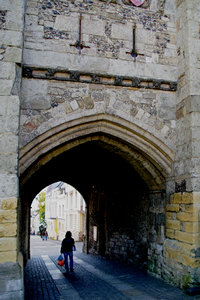Advertisement
Published: April 22nd 2015

 Westgate
Westgate
Security in the Middle AgesExcellent breakfast in the breakfast room which is a glass extension on the house. The son of the house served us a full English breakfast after our cereal and banana and orange juice – lovely orange egg, large slice of bacon (not side bacon, full bacon), two sausages, cherry tomatoes and a mushroom cap, with toast and marmalade and good coffee. Fuel for the whole day!
We set off for town feeling almost knowledgeable about the route. Our aim was the tourist centre for the 11:00
City walking tour. After saying to ourselves we should go directly there, we got waylaid by taking photos of the
West Gate. Plus, we went to the Cathedral Square and had to ask directions from the shop. So we were just in time to buy tickets. Our guide, Barbara, had a German accent; she said she had lived in Winchester for thirty years – longer than in Germany. Our fellow walkers were two Canadians – a father from Vancouver and his son who is studying in London.
Our first stop was in the Abbey Garden to view from a distance the statue of
Alfred the Great, founder of the Royal Navy. Of course the Victorians who erected it

 King Alfred grasping his sword
King Alfred grasping his sword
Victorian rectitude supported by his "cross"had no idea what he looked like and they portrayed him raising his sword like a cross, in a manner that would have sliced his palm open. His widow (a rarity in itself when women often died in childbirth) was “given” a nunnery to keep her busy as the abbess; but that building was completely destroyed by Henry VIII.
As we walked along, our guide gave us snippets of information. There have been settlements in the area from prehistoric times. The Romans had a city in this very location, and Roman walls and tunnels are found easily. They channeled the river,
Itchen, and relocated its course - later undone. The City is on a marsh, so there is water everywhere, now quite well channeled. Still this is why about 100 years ago
William Walker spent six years as a diver shoring up the south-east wall of the Cathedral because it was sinking catastrophically. There are several small statues to him. Ironically, after surviving extremely dangerous work he died of the Spanish flu after WWI.
As we walked around the
Cathedral, Barbara pointed out the evidence of its 500 years of construction, seen in the changing architectural styles. Although originally

 William Walker
William Walker
Saviour of the Cathedral, a hero for cultural historyNorman, it was updated to the Gothic with a high extension to the roof’s pointed and by carving the heavy columns to look like many thinner ones.
Ken Follett's Pillars of the Earth comes to mind.
Moving along up the Old High Street, Barbara pointed out the older buildings. The High Street used to be the sweeping Roman Road, but gradually some of the buildings encroached, giving it a “jog” halfway from the gate to the centre. This is similar to developments in Perugia seen on last year’s trip in Italy, except there the banks did the encroaching and the Roman Road was even grander.
The Pentice is now a building with three shops, but it used to be the woollen market. It is the only arcaded building (very low), done to keep the wool dry. In the corner near the Pentice is a now well-worn
statue (
Butter Cross) that marked the marketplace.
Through the West Gate and around a few buildings, we came to the Great Hall of
Castle Winchester which has the
Round Table. As it happens, it is not really the Round Table of the Knights. Historians believe it was built by King
Edward I, as
they know it dates to 1294 (carbon dating), and they think he probably made it for the wedding of his four children.
Henry VIII painted it with his own likeness as if he were King
Arthur and added all the names of the knights, presumably to bolster his dubious royal roots. In any case, it now hangs on the castle wall. Beside it is a smallish statue of
Victoria to commemorate her Jubilee. We ended our tour in the
museum of the West Gate, mainly to climb to the roof and take pictures. The West Gate is one of two remaining gates of the original five in Winchester that are still celebrated on the crest (along with two lions denoting a royal city).
For lunch we ate at Pasty Presto, exactly beside the market statue. It sells many kinds of Cornish
pasties. Then we window-shopped our way back to the Tourist Bureau to buy tickets for the afternoon tour. There they were very helpful in giving us directions to Chawton, Jane Austen’s house, and copying a bus schedule for us for Tuesday.
The afternoon tour started again in the Abbey Garden, then moved along the River Itchen. The river

 Modern Sculpture
Modern Sculpture
Church, State and Commerce on the Itchen Riveris fast flowing and used to power several mills, one of which remains and is a flour mill run by the
National Trust . The banks are all channeled, at least in the City, and sluice gates prevent it from flooding. We saw ducks and a swan, and locals are permitted to fish for trout.
This led us to the playing field of a “Public” (private) school, now called
The Pilgrims School funded and refurbished by Americans in the Georgian style during the Victorian era. This afternoon’s guide, named Ursula, was also a German and a long-time resident of Winchester. She told us that “public” schools gained that name because they were not monastic schools, that is, the public could attend them.
Winchester College was older than and the model for Oxford. It was established by the then
Bishop of Winchester.
Along the way Ursula pointed out that most walls and many buildings were of
flint stone, the only rock available. From a distance, cracked flint stones look like the inside of a large oyster shells. Mixed in the Bishop’s Wall and the City Wall were old tiles and bricks from Roman times. The English lost the knowledge of making these until the eighteenth

 Winchester Cathedral
Winchester Cathedral
The embodiment of light - in stone!century.
Following the walls we came to the
Kingsgate, the other remaining Gate. Inside the walls we entered the precinct of the Cathedral. There was a bit of repetition from the morning tour, but to the end this tour Ursula offered to take us through the Cathedral at a cost of £2, paid to the ticket booth, instead of the regular £4.
Up the central aisle of the Cathedral, the eye is drawn to the soaring columns lit by mainly (not all) stained glass windows. The stone is light grey so it looks light in itself. The huge stained glass window at the entrance (back of the main aisle) was shot out by soldiers (Cromwell). Because the locals couldn’t figure out how to form the picture again, they put it back together helter-skelter, creating a modern abstract effect. Ursula described the history of many commemorative grave plaques and statues. Many bishops “rest” in their own tiny chapels built in the main aisle behind the altar. The Cathedral is the longest in Europe (175 m) after the Vatican.
Of course our special interest was in
Jane Austen’s grave; according to Ursula she was the last person to be buried beneath

 Jane Austen's grave
Jane Austen's grave
Loving tribute from her family, nary a word of her writingthe Cathedral (1817) because of water problems. Her five brothers paid for her burial; the burial stone extols her virtues as a good person but does not mention her writing because she was not famous then. A hundred years later a large brass memorial plaque was erected on the wall near the grave under a stained-glass window dedicated to St. Augustine, a play on the name Austen. The
Jane Austen Society pays to have fresh flowers always there.
Behind the main altar is a space newly dedicated to
Taize services. We learned later that this is a form of worship from the South of France that involves meditation, kneeling, singing and more. A group of about seven new Russian-style icons are mounted in this “chapel”.
We wanted to attend
Evensong at 5:30. Tea was in order first, and we were so disloyal as to go to Starbucks on the High Street. We relaxed thoroughly on a soft couch while watching everyone else rush back and forth with their Saturday activities. We arrived again at the Cathedral with a minute to spare, only to be asked to wait for the processional by the men and boys choir and the priests. This

 Memorial Plaque
Memorial Plaque
Fresh flowers every week from the Jane Austen Societybrought us to the realization that the times posted were for the moment the priest starts the service. Anyway, we weren’t the only ones who quietly slipped across to seats. The Evensong was held in a large chapel behind the main altar with the choir and some attendees in the choir stalls and the rest of us in chairs further along. The choir sang beautifully, with the boys singing in that special soprano, sound floating to the high ceiling.
With dusk falling, we walked up the High Street to a very old building named
God Begot House, containing a very new Italian restaurant called “ASK”. Earlier Barbara had taken us upstairs to see the old ceiling and hammered beams taken from ships. Now we were seated on the main floor where we could watch the waiters literally running up and down the stairs, yet their service was charming, not hasty or rushed. We shared a starter of stuffed mushrooms served on a cast iron hot plate. Then Deirdre had risotto and I had penne and chicken in a pesto sauce. Delicious!
View
map View


























Isabel Gibson
non-member comment
Boy, I'll say you had a busy day - and a well-researched one, too, it would appear, to take in two good tours. And maybe some sensible opportunism (in the good sense) in choosing where to eat dinner. Great shots, especially of the cathedral's interior. I wonder if Jane ever dreamt about what her place would be in literary history?